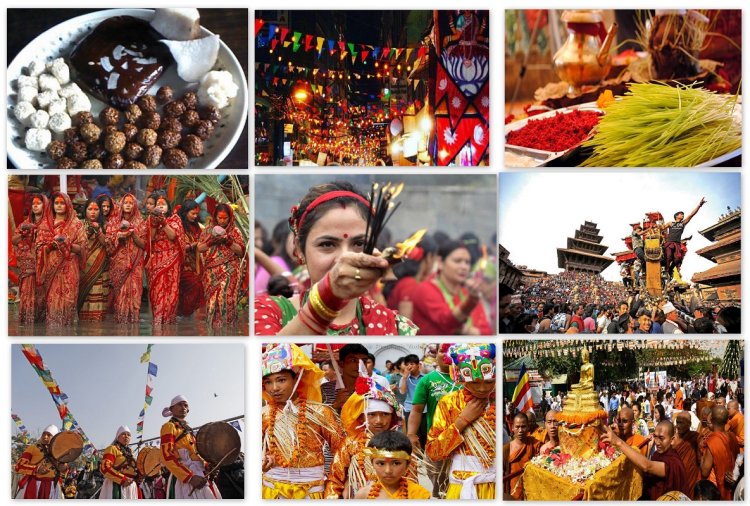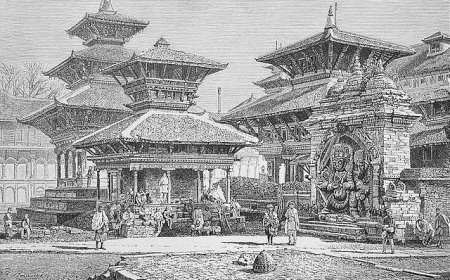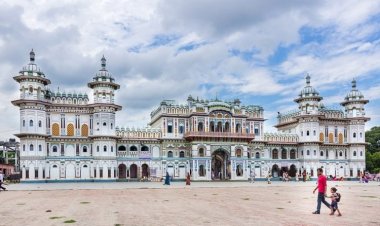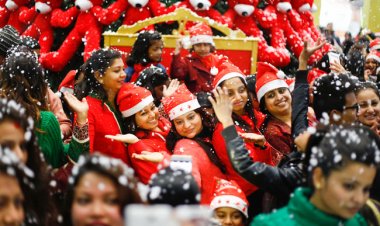Nepalese Festivals - Festivals of Nepal
Nepalese Festivals Learn about Nepal's culture through festivals like Dashain, Tihar, Holi, Teej, Janai Purnima, and Buddha Jayanti.

Nepal is a country rich in cultural diversity, with festivals playing a central role in Nepalese society. Influenced by Hinduism, Buddhism, and other religious traditions, these festivals serve as a means to celebrate life, honor deities, and bring families and communities together. Below is a detailed look at some of the most important festivals celebrated in Nepal.
1. Janai Purnima (Raksha Bandhan)
Janai Purnima, often referred to as Raksha Bandhan, is a Hindu festival that takes place on the full moon day in the month of Shrawan (July to August). This day holds great Purpose for the Brahmin and Chhetri communities of Nepal, as it involves the changing of the sacred thread called "Janai." For others, it is a day to celebrate the bond between brothers and sisters through the ritual of Raksha Bandhan.
Traditions:
On this day, Brahmin men change their Janai, a sacred thread worn around the body. This is done after taking a holy bath and performing prayers. For others, Raksha Bandhan is celebrated by sisters tying a sacred thread called "Doro" around their brothers’ wrists as a symbol of love and protection. In return, brothers offer gifts to their sisters and vow to protect them throughout their lives.
Purpose:
Janai Purnima marks purification, renewal, and protection. It also signifies the bond between siblings, celebrating unity and familial love. For Brahmins, it is a day of spiritual renewal, while for others, it’s a celebration of sibling relationships.
2. Teej
Teej is a unique festival dedicated to women in Nepal, where they come together to celebrate the union of Lord Shiva and Goddess Parvati. This Hindu festival is observed with joy, fasting, and prayer for the well-being of husbands and family members. It usually takes place in August or September, during the monsoon season.
Traditions:
On Teej, married women and young girls dress in red saris and ornaments and gather at temples to offer prayers. They fast throughout the day, some without even drinking water, praying for the long life of their husbands or future husbands. The festival is also marked by songs, dances, and communal gatherings. Women visit their maternal homes, share meals, and celebrate their sisterhood.
Purpose:
Teej celebrates womanhood and the bond between husband and wife. It also symbolizes devotion, love, and marital bliss. The fasting is believed to bring happiness and longevity to their husbands, making it an important festival for Hindu women.
3. Dashain
Dashain is the longest and most significant festival in Nepal, celebrated by Hindus for 15 days during September or October. The festival commemorates Goddess Durga's victory over the demon Mahishasura, representing the ultimate triumph of good over evil. Dashain is a time of family reunions, prayers, and celebrations.
Traditions:
Dashain begins with Ghatasthapana, where a sacred vessel is placed in homes, and barley seeds are planted to represent prosperity. Families worship the goddess Durga, seeking her blessings. Throughout the festival, people visit relatives, fly kites, and receive "Tika" (a mixture of rice, yogurt, and vermilion) and "Jamara" (barley sprouts) from their elders. Animal sacrifices are also performed as offerings to the goddess Durga.
Purpose:
Dashain is a time of victory, family bonding, and reverence to the goddess Durga. It is a celebration of prosperity, happiness, and the triumph of virtue over vice. The festival brings families together from across the country, fostering unity and love.
4. Tihar (Yama Panchak)
Tihar, also known as Yamapanchak or Deepawali, is the festival of lights celebrated shortly after Dashain, usually in October or November. It lasts for five days and honors animals, the goddess Laxmi, and the bond between brothers and sisters.
Traditions:
Each of the five days of Tihar is dedicated to a different ritual. The first day is Kag Tihar, where crows are worshiped. The second day is Kukur Tihar, dedicated to dogs. The third day, Gai Tihar, is when cows are revered, followed by Laxmi Puja in the evening, when homes are illuminated with oil lamps to welcome the goddess of wealth. The fourth day is dedicated to oxen, and the fifth day is Bhai Tika, where sisters perform Traditions for their brothers, applying Tika and exchanging gifts.
Purpose:
Tihar celebrates the bond between humans and animals, as well as the brother-sister relationship. It is a festival that honors nature, wealth, and family ties, making it one of the most cherished festivals in Nepal.
5. Holi (Fagu Purnima)
Holi, the festival of colors, is celebrated in March to mark the arrival of spring. It is observed with great enthusiasm across Nepal, with people throwing colored powders and water at each other. Holi is also a symbol of the victory of good over evil, commemorating the story of Holika, a demoness who was defeated by devotion to Lord Vishnu.
Traditions:
People gather in the streets, public squares, and rooftops to throw vibrant colors and water balloons at each other. Singing, dancing, and feasting are also common during Holi. In many parts of Nepal, a ceremonial fire is lit the night before the celebration to symbolize the burning of evil.
Purpose:
Holi brings joy, unity, and a sense of renewal as it celebrates the end of winter and the arrival of the blooming season. It symbolizes the victory of good over evil and the celebration of life, love, and color. Holi is one of the most joyous and energetic festivals in Nepal.
6. Buddha Jayanti
Buddha Jayanti is the most important festival for Buddhists in Nepal and around the world. It celebrates the birth, enlightenment, and death (Maha Parinirvana) of Gautama Buddha, the founder of Buddhism. This festival is observed on the full moon day in the month of Baisakh (April-May) and is celebrated with great reverence in Nepal, especially in areas with a significant Buddhist population.
Traditions:
On Buddha Jayanti, devotees visit Buddhist stupas and monasteries, such as Swayambhunath and Boudhanath in Kathmandu, to offer prayers, light candles, and make offerings of flowers and incense. The day is marked by peaceful Traditions, including meditation, chanting, and parades. Lumbini, the birthplace of Buddha in Nepal, becomes a focal point of celebrations where pilgrims from all over the world gather.
Purpose:
This festival commemorates the three key events of Buddha's life: his birth, enlightenment, and passing into Nirvana. It promotes messages of peace, non-violence, and compassion, aligning with the core teachings of Buddhism. Buddha Jayanti is a day of spiritual reflection and a reminder of the impact of Buddhism on Nepalese society and the world.
7. Shivaratri
Shivaratri, or Maha Shivaratri, is a major Hindu festival dedicated to Lord Shiva, one of the principal deities in Hinduism. This festival falls on the 14th day of the waning moon in the month of Falgun (February-March). It is one of the most important nights for Shiva devotees, who stay awake and worship throughout the night.
Traditions:
The most prominent celebrations of Shivaratri take place at the Pashupatinath Temple in Kathmandu, where thousands of devotees gather to offer prayers to Lord Shiva. People fast, chant "Om Namah Shivaya," and offer Bilva leaves, milk, and holy water to Shiva's idols. Temples are adorned with oil lamps, and many people spend the night in vigil, praying and meditating.
Purpose:
Shivaratri is believed to be the night when Lord Shiva performs his cosmic dance, known as Tandav, which represents the creation, preservation, and destruction of the universe. Devotees believe that fasting and praying on this night will absolve them of sins and bring spiritual enlightenment. It is a festival that emphasizes devotion, self-control, and renewal.
8. Maghe Sankranti
Maghe Sankranti, also known as Makar Sankranti, marks the transition of the sun from Sagittarius to Capricorn in the Hindu calendar. This festival is celebrated in mid-January and signifies the end of winter and the beginning of longer days. IThe day is marked by joyful family reunions and feasts.
Traditions:
On Maghe Sankranti, families prepare and enjoy traditional foods such as ghee, sesame seed laddus, yam, and molasses. It is believed that eating these foods brings good health and strength. Devotees take holy baths in rivers, especially at places like Devghat, where the Trishuli and Kali Gandaki rivers meet. People also visit temples and offer prayers for a prosperous and healthy life.
Purpose:
Maghe Sankranti marks the beginning of the harvest season and is a festival that celebrates the end of winter's hardships. It is a time for family gatherings and feasts, and for Hindus, it holds religious Purpose as a day of spiritual cleansing and prayer.
9. Gai Jatra
Gai Jatra, known as the 'Festival of Cows,' is a distinctive celebration observed mainly in the Kathmandu Valley. It is held in memory of family members who have passed away during the year. Gai Jatra falls in August or September, and the central feature of the festival is a procession of people dressed in costumes and accompanied by cows, as cows are believed to guide the souls of the deceased to heaven.
Traditions:
Families who have lost loved ones during the past year join a procession with cows or children dressed as cows through the streets of Kathmandu. This procession is lively and often includes satirical performances, music, and dance. People also perform various acts of charity, such as distributing food and alms to the poor, believing this will help the souls of the deceased find peace.
Purpose:
Gai Jatra is both a time of mourning and celebration, as it helps families cope with their grief by turning sorrow into laughter. The festival is also a form of social commentary, with people poking fun at societal norms, politicians, and events through humorous performances. It is a celebration of life and death, offering comfort to grieving families while embracing joy and humor.
10. Indra Jatra
Indra Jatra is one of the most vibrant festivals celebrated in Kathmandu, dedicated to Lord Indra, the god of rain and king of heaven in Hindu mythology. It takes place in September and lasts for eight days, coinciding with the end of the monsoon season. The festival is especially important for the Newar community of the Kathmandu Valley.
Traditions:
The festival begins with the raising of a ceremonial flagpole (Yosin) in Kathmandu’s Durbar Square. The highlight of Indra Jatra is the Kumari Jatra, where the living goddess Kumari is paraded through the streets in a chariot. The festival also features masked dances (Lakhey dance) representing deities and demons. People offer prayers to Indra, thanking him for the rain and good harvest.
Purpose:
Indra Jatra is a festival of gratitude for a bountiful harvest and rain, essential for Nepal’s agrarian society. The chariot procession of the Kumari goddess is a significant religious event that symbolizes the divine protection of the city. Indra Jatra is a time of celebration, unity, and cultural pride for the people of Kathmandu.
11. Losar
Losar is the Tibetan New Year, celebrated with great enthusiasm by the Tibetan, Sherpa, and other Himalayan communities in Nepal. This festival is usually celebrated in February and marks the beginning of the lunar calendar. In the Tibetan language, "Lo" translates to "year," and "Sar" means "new." Losar is a time of renewal, community gathering, and spiritual Traditions.
Traditions:
Preparations for Losar begin days before the actual event. Homes are thoroughly cleaned and decorated with prayer flags. Special dishes like "Guthuk," a noodle soup, are prepared and shared among family members. On the first day, families visit monasteries and make offerings to the deities, seeking blessings for a prosperous year ahead. Traditional dances, songs, and prayers are performed, and people visit friends and relatives to exchange gifts and best wishes.
Purpose:
Losar signifies the start of a new year and is a time for people to cleanse themselves of the past year's negativities. It’s not only a celebration of time and renewal but also an occasion for strengthening family bonds, promoting peace, and performing acts of charity. The festival embodies the values of community spirit and religious devotion.
12. Ghode Jatra
Ghode Jatra, or the "Festival of Horses," is a unique event celebrated in Kathmandu to ward off evil spirits. It is believed that a demon named Tundi once terrorized the Kathmandu Valley, and after his defeat, a grand horse parade was organized to celebrate. This festival falls in March or April and is observed with much excitement, especially by the Newar community.
Traditions:
The most important event of Ghode Jatra is the horse parade at Tundikhel, a large parade ground in the heart of Kathmandu. The Nepali army displays its skill in horse riding, showcasing exciting stunts and performances. Dignitaries, including the president and prime minister, attend the event. The festival is also marked by traditional Newari Traditions and feasts in local communities.
Purpose:
Ghode Jatra is considered a symbol of victory over evil, as it celebrates the defeat of the demon Tundi. The thundering sound of horses running is believed to keep his spirit from rising again. The festival highlights Nepal's military prowess and cultural heritage, blending religious belief with national pride.
13. Chhath
Chhath is a major festival celebrated primarily by the Madhesi community in the southern plains of Nepal, known as the Terai. Dedicated to the Sun God (Surya), Chhath Puja is one of the oldest Vedic festivals, symbolizing health, prosperity, and well-being. It usually falls in November and lasts for four days.
Traditions :
The four-day festival begins with Nahay Khay, where devotees take a ritual bath in rivers and lakes. On the second day, people fast and prepare offerings of fruits, sweets, and grains. The third day is the main event, where worshippers gather at riverbanks at sunset to offer prayers to the setting sun. The final day, known as Usha Arghya, involves similar prayers at sunrise. Devotees stand in water for long hours, offering prayers and lighted lamps to the Sun God.
Purpose:
Chhath is a deeply spiritual festival that honors the life-giving energy of the Sun God and promotes gratitude for health and prosperity. It is also a festival of purity, as devotees observe strict fasting and cleansing Traditions. Chhath connects families and communities, fostering devotion and unity.
14. Bala Chaturdashi
Bala Chaturdashi is a Hindu festival observed in memory of deceased family members. It is celebrated at the Pashupatinath Temple in Kathmandu and lasts for two days, falling in November or December. The festival is named after the act of scattering "bala" (grains) to honor the souls of the departed.
Traditions:
On the first night, families keep vigil by lighting oil lamps and performing prayers for their deceased loved ones at Pashupatinath. The next morning, devotees gather to scatter seven types of grains along a specific route around the temple. This ritual, known as Saptashrungi, is believed to bring peace to the souls of the deceased. Offerings of food, flowers, and prayers are also made during this time.
Purpose:
Bala Chaturdashi is a festival of remembrance and respect for the dead. It gives families a chance to honor their ancestors and departed loved ones by performing Traditions meant to ease their journey in the afterlife. The festival brings people closer to their spiritual beliefs and family heritage.
15. Fagu Purnima (Holi Festival)
Fagu Purnima, more commonly known as Holi, is the festival of colors celebrated with exuberance in Nepal and many parts of South Asia. This festival marks the end of winter and the arrival of spring, falling in March. Holi also celebrates the victory of good over evil, rooted in the legend of Holika and Prahlad.
Traditions:
On the eve of Holi, bonfires are lit to symbolize the burning of Holika, a demoness who tried to kill Prahlad, a devotee of Lord Vishnu. On the following day, people of all ages celebrate by taking to the streets and playfully throwing colored powders and water at one another. The streets are filled with vibrant music, lively dancing, and joyful laughter during the festivities. It is also a time for sharing sweets and visiting friends and family.
Purpose:
Holi represents the triumph of virtue and the spirit of community. It is a time to forgive, forget, and renew relationships. The festival is known for its sense of freedom and joy, with people of all backgrounds coming together to celebrate with color and fun. Holi is not just about revelry but also about the renewal of social bonds and cultural traditions.
What's Your Reaction?





































































































